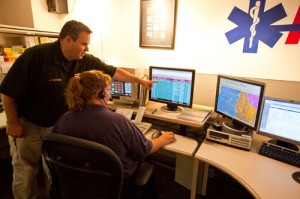Starting from Scratch

Some skills are better taught outside the classroom in a hands-on environment. (Photo Michael Coppola)
Developing training, whether it’s a single class or a comprehensive agency program, can be daunting. You may find it more manageable, if you follow four simple steps.
1. Evaluate your agency’s needs: Your first step in developing a training program is to identify what your employees need to know. A few methods you can use:
Interviews: Seek feedback from those within your agency who do the job every day: the telecommunicators. Also, speak with supervisors, your user agencies, customers and subject matter experts. What do they think your telecommunicators need to know and why?
Interviews can be conducted face to face or via phone. The questions for each group are usually the same. You can ask follow up questions to clarify and expand on the participant’s feedback.
Surveys: A survey allows you to ask multiple people the same questions you would in an interview without any logistical issues. Several quality online survey service providers, such as SurveyMonkey, allow users to create custom electronic surveys for little or no cost.
SOP review: It’s imperative that your training materials not contradict your agencies policies and procedures. By reviewing your standard operating procedures (SOPs), you’ll ensure consistency between your policies and training. This review can also help you identify topics and information to include in your curriculum.
Industry standards and best practices: Does your curriculum comply with established industry standards and best practices? Do the research necessary to answer this question.
If you’re developing a training program, there’s no greater resource than the APCO International Minimum Training Standards for Public Safety Telecommunicators (APCO ANS 3.103.1-2010). Additional APCO resources can be found at www.apcostandards.org.
2. Identify your delivery method: Classroom training can be expensive, especially when it involves overtime and shift backfill for employees to attend, but not all training requires a classroom. Time-efficient and cost-effective alternate delivery methods include:
Online/electronic training: This can be as simple as e-mailing a PowerPoint presentation to employees or signing up for an online course delivered by another agency, such as FEMA’s Independent Study Program.
Independent study: Independent study can include the review of written materials and training DVDs, or even review of a “call of the week” from your agency. Programs can also take advantage of the continuing education articles in this magazine.
One-on-one training: Some skills are better taught outside the classroom in a hands-on environment.
Whatever training method you choose, ensure you can track and document that the trainee has completed the course work.
3. Evaluation: It’s important that the material you deliver and how you deliver it produce the desired performance outcome. This assessment can be accomplished through evaluations, but not all effective learning evaluation tools are written tests. Depending on the topic and the desired outcome, the most appropriate tool to measure learning may be a practical skills assessment.
4. Curriculum review: To ensure your material remains accurate, complete and compliant with SOPs, standards and best practices, you must conduct regular reviews. Ideally, the best time to do this is at the end of each training class or module. After the training, compare your performance expectations with the actual performance outcomes.
Another review method: Solicit feedback from your trainees, and seek input from your trainers and supervisors. Individuals working with the trainees will be able to identify gaps in the learning process.
A Case for Certification
Training program certifications demonstrate to your employees, customers and citizens your agency’s commitment to meeting established national standards and best practices. Because you’ve already used the published standards and best practices as guides to develop your curriculum, certification shouldn’t be difficult or expensive. Two prominent national training program certifications are:
APCO Project 33 (P33) Agency Training Program Certification: P33 is a formal mechanism for public safety agencies to certify their training programs as meeting APCO American National Standards (ANS). Learn how to submit your agency’s program for P33 certification at https://p33.apcointl.org/.
National Center for Missing and Exploited Children (NCMEC) 9-1-1 Call Center Partner Program: To be recognized as a NCMEC 9-1-1 Call Center Partner, agencies must demonstrate that they have formally adopted and trained their employees on APCO ANS 1.101.2-2010: Standard for Public Safety Telecommunicators when Responding to Calls Pertaining to Missing, Abducted and Sexually Exploited Children. Learn more at www.missingkids.com/911.
For telecommunicators to be effective and meet your customers’ needs, your agency must have a comprehensive training program to support them. Training is not a luxury, it’s a necessity.
About the Author
Julie Buckingham is the training coordinator for NORCOM in Washington and can be reached at jbuckingham@norcom.org.
Originally published in Public Safety Communications, Vol. 77(7):18, July 2011.

